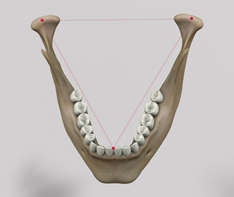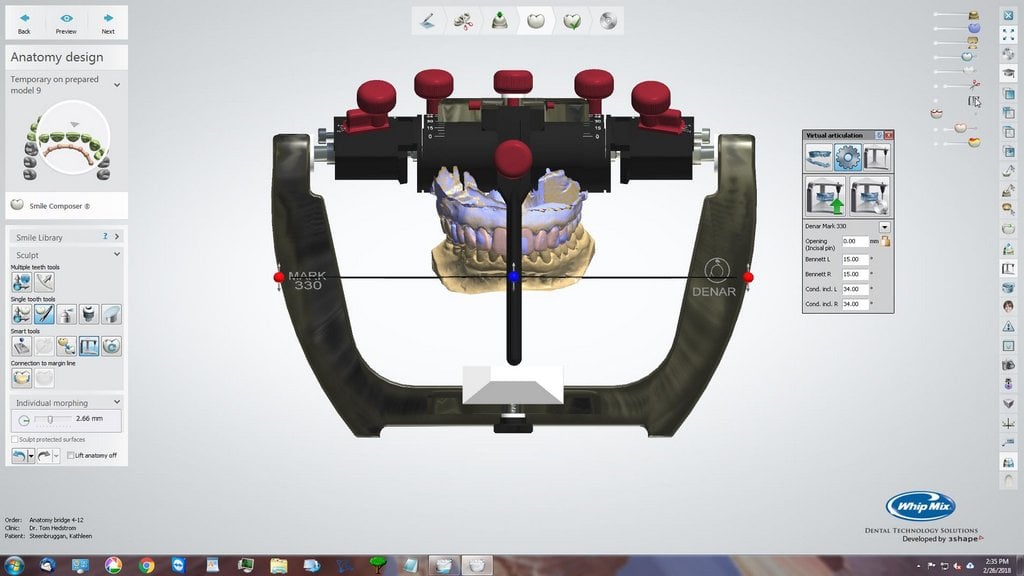In Part 1 of this Blog, we covered the basic description of semi-adjustable articulators, how they function and why they are important. In Part 2, we'll define some of the settings that semi-adjustable articulators offer to bring the instrument as close as possible to recreating the movements in the mouth.
Some definitions for adjustable articulation
Condylar Inclination setting Most instruments offer a setting of between 0 and 70 degrees for the protrusive angle/guidance. This setting is usually located on or next to the condylar guide.
The purpose of this setting is to simulate the angle that the condyle will travel as it leaves the fossa and moves downward and forward against the superior wall or eminence. Using a protrusive bite record is the common method for recording this angle and setting the instrument. When bringing the lower jaw forward and down, the eminence will cause the mechanical condyle on the lower member of the articulator to drop and move away from and down the condylar element of the upper member. It should be noted that I am describing the movement of an ARCON type articulator with an open fossa design.
An open fossa design means that there is nothing to keep the upper member against the lower member when the latch is unlocked. Most manufacturers have open-fossa-design articulators. If you are going to be setting an instrument using a protrusive bite record, I recommend this design for ease and quick verification.
Bennett Progressive Side Shift The purpose of the Bennett Progressive Side Shift is to simulate the angle or degree the non-rotating condyle will travel when the lower jaw moves to the working side (this is the side towards which the mandible moves). Most common settings available for this angle on the articulator ranges from 0 to 30 degrees. The lateral angle can be captured by taking a lateral bite record and programming the articulator accordingly. Some instruments have preset angles already established, using clinical research and documented studies from respected clinicians in dentistry.
Bennett Immediate Side Shift The purpose of this setting is to incorporate a straight movement laterally before translation of the condylar, as it begins its journey down the eminence. The most common settings available on the articulator range from 0 to 4 mm. The effects of not incorporating this shift could result in immediate interference during lateral movements.
Adjustable Intercondylar Width Only small number of articulators feature an adjustable intercondylar width. If you have a Semi-adjustable articulator with a fixed intercondylar width, you are not alone. Studies by Bonwill have proven that most patients will fall within the average distance of 110 mm. Bonwill’s Triangle is an equilateral triangle formed by lines from the contact points of the lower central incisors (or the median line of the residual ridge of the mandible), to the center of the mandibular condyle on each side and from one condyle to the other (Fig 5). William G.A. Bonwill, 1833-1899. Because the doctor needs additional tools, like the Cadiax mandibular recording device, it is not common, nor necessary, as viewed by many clinicians to incorporate this setting.

Fig. 5
In addition to these adjustments, it is extremely important that the articulator be a full size instrument with the capability to accept a face-bow registration.
Why is this important? Having a full size articulator will produce arcing movements at the same rate as the patient.
To understand the importance of this feature alone is justification enough for using a full-size articulator. I cannot stress enough what using a full-size articulator will do for your confidence. Matching the patient’s arcing movement drastically reduces - and in most cases eliminates - posterior interferences during delivery of the completed case. The only other missing part would be the absence of an accurate face-bow registration (Fig. 6).

Fig. 6
Capturing an accurate face-bow registration is usually the job of the dentist or someone on his/her staff. There are some labs that receive face-bow registrations from the dentist and instructed to mount the casts. If this is the case with your laboratory, it is very important that, if the bite doesn’t look correct, you should contact the dentist for verification. Do not change the angle of the bite you receive. Face-bows have evolved over the years to make that procedure easier and quicker.
Understanding the basics of the articulator and what it do can for you will have a huge impact on the outcome on the cases fabricated using them. How you go about selecting one and knowing what the adjustments can do for the occlusal scheme you want to develop or follow is central to the successful delivery of the completed case.











.png)
Leave a comment